What Makes a Headline Successful?
Studies show that out of every 10 online users that see your headline, only eight of them will actually read it and only two will take the time to read the actual content.
With that said, you’ve probably heard that the average internet user’s attention span is shorter than that of a goldfish: eight seconds on average. If you want people to read your content, you need a powerful headline.
The purpose of a headline is to grab users’ attention. To accomplish this goal, your headline has to be unique, specific, useful, and, on top of that, convey a sense of urgency. Successful headlines include an underlying reason why users should read your content. For example, the focus of your headline could be on a problem your audience has, a benefit they will get from your content, or a specific result they will be able to achieve.
There are many types of headlines, and you can combine multiple headline formulas to get the perfect title for your content. In this article, we list some of the best headline examples and include specific proven formulas. We also outline the do's and don'ts to keep in mind when writing a headline, and a step-by-step process to create one.
46 Different Types of Headlines + Examples
The two main goals of your headline are to generate interest and communicate what users will get. Below, you can find the formulas for headlines that will help you achieve both goals.
The "How To" Headline
One of the main reasons people consume content is to learn a new skill or learn to overcome a challenge. If you have an informative piece of content, you can use a “How To” headline to provide a solution to the problem. This is the ideal headline for step-by-step guides that explain how to reach an objective in detail.
To make your “How To” headline successful, make the problem as specific as possible. You can do this by specifying who the audience is (e.g., beginners) or by explaining what content format you’ll deliver (e.g., a step-by-step guide).
Formula
- How to + [Your audience’s goal]
Examples
- How to Make a Website in 2021: Step-by-Step Beginner's Guide
- How to Speed Up Your Website (20+ Practical Tips)
- How to Start an Online Store (From Start to Finish)
The “Reasons Why” Headline
As humans, we have an ingrained curiosity about the “why” behind things, especially when it comes to things we care about. You can take advantage of this psychology to present your informative content in a way that stimulates curiosity.
With the “Reasons Why” headline, you’ll promise to explain why a problem your audience faces exists — and you’ll also present a solution throughout the content. This is a good opportunity to grab the attention of users who are facing a specific problem and don’t know why.
Consider using this headline formula to create some controversy (more on how to do this later). But to be successful, make sure you have good data to support your argument.
Formula
- [Number] + Reasons Why + [Audience’s pain point]
Examples
- 21 Life-Changing Decisions To Make in 2022
- Three Reasons to Safely Drink out of Plastic Water Bottles
- Ten Reasons to Quit Your Coffee
The “Question” Headline
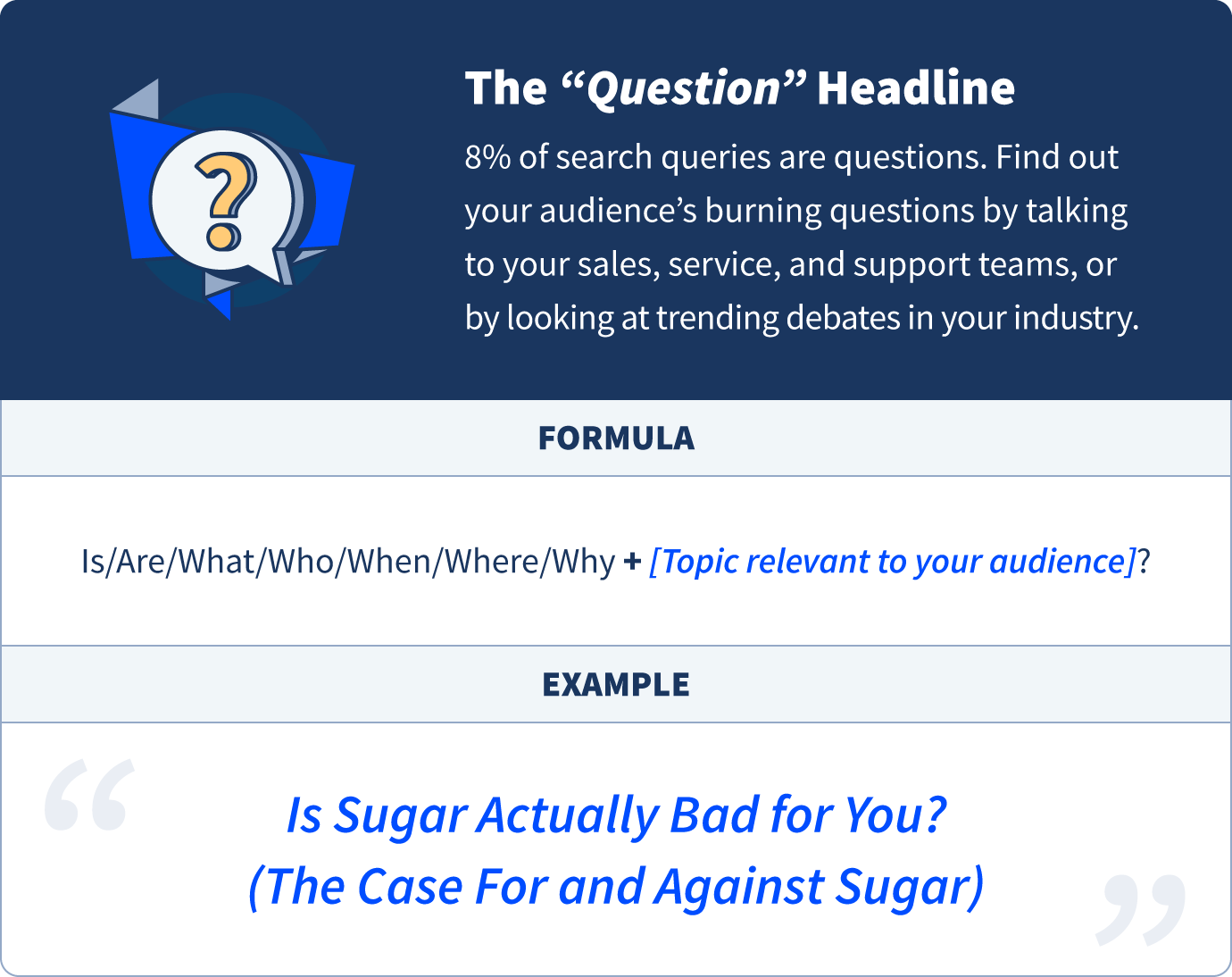
One of the reasons people turn to Google is to find an answer to a specific question. One study found that about 8% of search queries are questions.
If you have informative content, try going with a question headline. With this type of headline, you have a good chance of delivering exactly what your audience is looking for. Framing your headline as a question is effective because it switches the readers’ role from passive to active, and creates engagement. If the question is relevant to them, it will trigger their curiosity and interest.
To ask relevant questions, find out your audience’s burning questions by talking to your sales, service, and support teams, or spend time looking at trending debates in your industry. Make sure you don’t use a question that your audience likely has an answer to already. If they do, they won’t be triggered to click.
Depending on the type of content, you can either go with an informational and specific question or with a more controversial and provocative one (more on how to do that later).
Formula
- Is/Are/What/Who/When/Where/Why + [Topic relevant to your audience]?
- What is [Topic relevant to your audience]?
Examples
- Do You Close the Bathroom Door Even When You’re the Only One Home?
- What’s Scarier Than the Sex Talk? Talking About Food & Weight!
- Is Sugar Actually Bad for You? (The Case For and Against Sugar)
- Hire a Web Developer or Do it Yourself?
The “Benefit” Headline
All successful headlines should imply that users will gain something from consuming the content. However, not all headlines explicitly express what the benefit is.
With the benefit headline, instead of using fancy data or formulas to grab the reader’s attention, you will openly state what benefit your content will bring to your readers. Using this type of headline is the best choice if your audience consists of busy people who prefer that you get straight to the point.
To create a successful benefit headline, consider what key benefits users can achieve by using your content. You can use another headline formula in this list (such as the how-to headline) but shift the focus to the real-life benefit users will get. You can use words like “increase” and “boost” to do that effectively, but make sure you address your audience’s goals.
Formula
- [Number or How to] + [Benefit to your audience]
Examples
- How to Speed Up Your Website (20+ Practical Tips)
- 33 Proven Ways To Monetize a Website (or a Blog)
- 35+ Ways to Increase Website Traffic (Free & Paid Strategies)
The “Proof” Headline
When it comes to informative content, it can be hard to capture the users’ attention, especially if it’s a topic that has been covered many times already. Using social proof is an effective method to capture your audience’s attention quickly because people have a natural tendency to engage in actions that other people are doing. The proof headline works especially well for content like case studies, whitepapers, and eBooks, but you can also use it to back up the content in your blog post.
To make your proof headline successful, make sure you focus on explaining what problem you will help the users overcome. The proof you include can consist of a statement from an industry expert, a quote from a report, or a statement from a resource your audience trusts.
You can also use a direct quote in your headline as a way of gaining interest through social proof. This can be even more powerful as it states what the trusted source thinks without filters.
Formula
- [Trusted source] + [Solution] + [Result] + [Problem your audience faces]
Examples
- A powerful money lesson from Bill Gates: Why you should save like a pessimist, but invest like an optimist
- Why Red Bull Uses Social Media to Get New Customers (Instead of Only Advertising)
- 3 Ways to Manage Teams like Elon Musk
- ‘Buy Bitcoin’ Says Expert as Argentina Imposes $10K Limit for Citizens
The “Positive Emotion” Headline
CoSchedule analyzed millions of headlines and found that posts with a higher “emotional value” are shared more often. In particular, they found that headlines with positive emotions are more likely to encourage shares, so consider using words that are motivational or give hope to your audience in the headline.
Using positive emotions can help you get clicks and shares, but it’s important that you don’t overuse emotional words. According to Buzzsumo, emotional headlines are not as powerful as they were in the past. They are still great if they’re used to refer to unusual information, but excessively emotional headlines can be counterproductive.
To create a headline with positive emotion, you can use the Headline Analyzer tool created by the Advanced Marketing Institute. If you get an Emotional Marketing Value (EMV) lower than 30, try adding positive emotion words like “amazing,” “master,” “hope,” and “win.” Alternatively, you can use words like “easy” to help users feel confident about their goals.
Formula
- [Positive Emotion Word] + [Benefit]
Examples
The “Mistakes” Headline
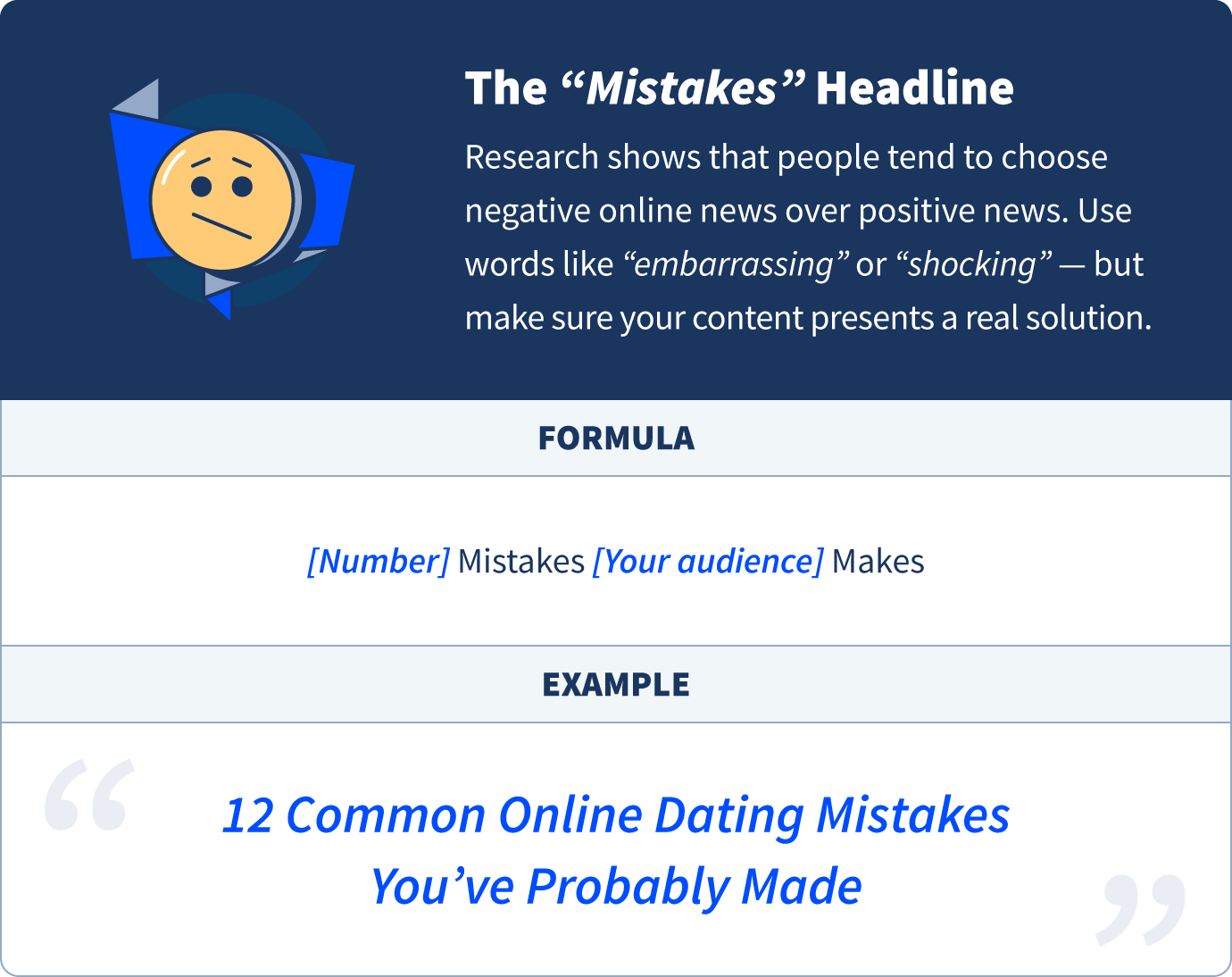
As you’ve seen, using emotion in your headline can be a powerful way of generating interest. We’ve covered the benefits of using positive emotions, but could negative emotions in your headlines work too? Research shows that people who say they would like more positive news tend to choose online news that conveys negativity more often than positivity.
A good example of using negative emotions in your headlines is the mistakes headline, which you can use to pull on your target audience’s common fears. The idea here is that your audience will be enticed to find whether they’re doing something wrong.
To create an effective mistakes headline, you can use words like “embarrassing” or “shocking.” But make sure your content presents a real solution to overcome these errors.
Formula
- [Number] Mistakes [Your audience] Makes
- Do you make these Common [Audience/Topic] Mistakes?
Examples
- Are You Making These Embarrassing Mistakes at Work?
- 12 Common Online Dating Mistakes You’ve Probably Made
- Don't make this dangerous summer buggy mistake
The Secrets Headline
The key to a successful headline is to explain the benefits readers will get from your content, while, at the same time, creating interest. One way to do this is by using the secrets headline formula, where you mention the word “secret” or “secrets” to promise your audience you’ll cover new approaches to reach their goals.
Since the secrets headline has been overused especially by low-quality entertainment websites, you have to use it wisely. To use it successfully, make sure you actually reveal a secret in your content. It shouldn’t be a fact everyone knows already — that wouldn’t be a secret!
Formula
- The Secret(s) To + [Your audience's goal]
Examples
- 8 Secrets to Successful Online Marketing
- The Only Fluffy Pancake Secret You'll Ever Need
- The Secret to Nailing Your Home Loan Interview
The “Warning” Headline
Another way of using negative emotions in your headline is the warning title. This will almost always catch people’s attention, but make sure you explain to your audience why they should read the content.
Compared to other types of headlines, the warning headline is a great way to create a sense of urgency. It’s like saying: “The threat is here and now, and you need to do something about it — read this to get a solution now.”
You can choose to start your headline with “Warning:” and then explain the threat, or you can use the word “warning” throughout the title. Alternatively, you can choose to imply that there is a warning by using synonyms and words related to the threats. Just like with the mistakes headline, make sure you present a solution to the problem throughout your content.
Formula
- Warning: [Threat] + [Problem your audience faces]
- [Number] Warning Signs That [Problem your audience faces]
Examples
- Warning: These 10 everyday traps will make you fat
- 7 Warning Signs of Career Burnout to Recognize Before It's Too Late
- Do you Recognize These Early Warning Signs of an Egocentric Resume?
The “Problem” Headline
Why do you create content? In many cases, your goal is to solve a problem your target audience faces. If your piece solves a common and important problem, you can add that to your headline. One of the best ways to shift the focus from the content to the readers is to set up the headline with the problem, and then offer a way to overcome it.
To create a successful problem headline, start your title with the problem your audience faces. Then, briefly explain that your content will help them find a solution by using phrases like “here’s what to do about it” or “here’s the solution.”
Formula
- [Problem] + [What to do about it]
Examples
- Lack Time? Here's 4 Convenient Ways to Keep Your Dog Fit
- The Problem with Financial Incentives — and What to Do About It
The “Result” Headline
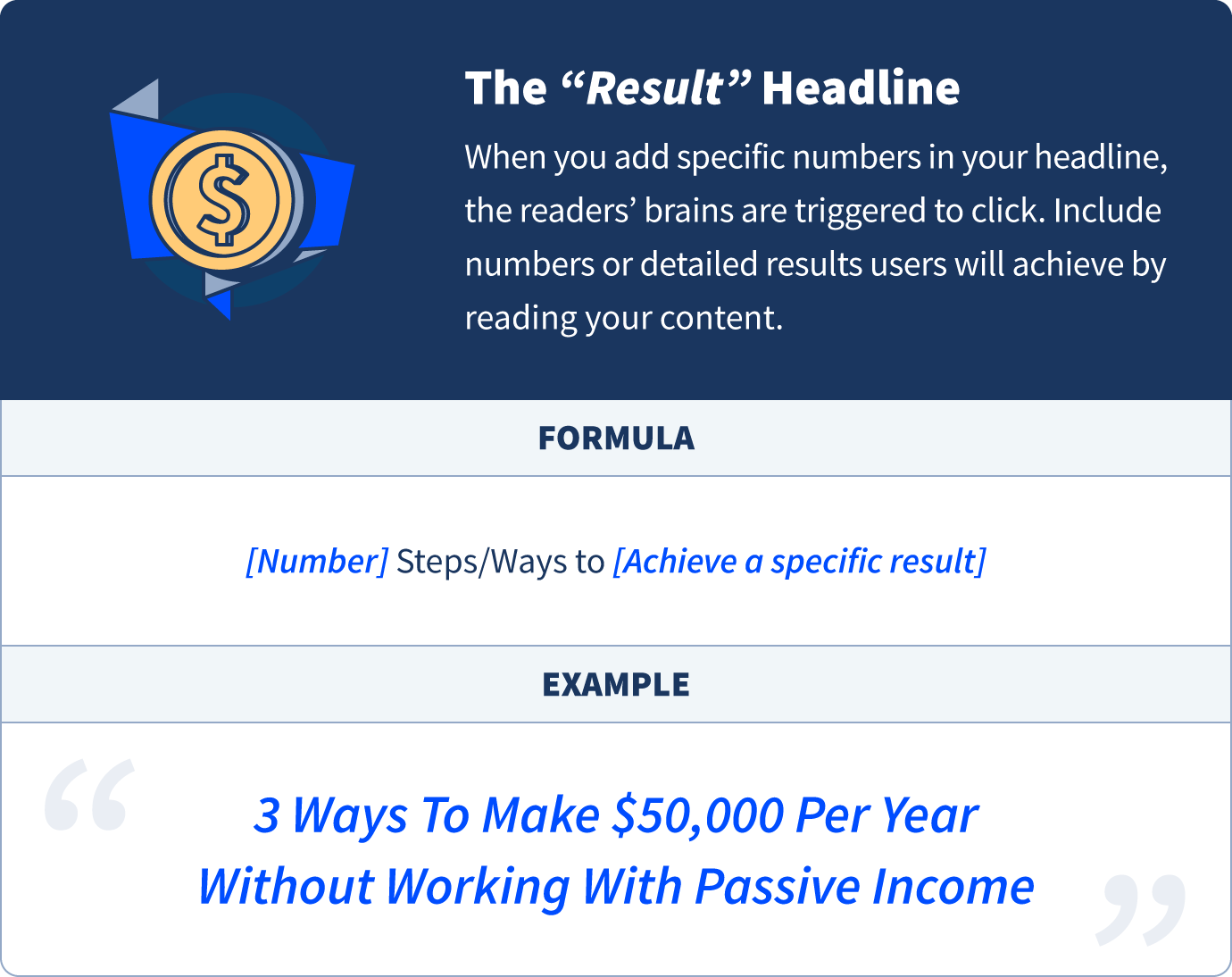
With the problem headline, you focus on the problem your target audience has. With the result headline, you shift the focus to the outcome your audience can achieve by consuming your content. This headline formula is one of the most effective types of headlines because it tells exactly what users can achieve by reading your content. According to marketing expert Mike Hamers, when you add specific numbers in your headline, the readers’ brains are triggered to click on your content because they automatically organize information into a logical order.
When using a results headline, make sure you don’t promise too much and stick to what you can deliver. Make sure your results are specific by including numbers, detailed results, or a timeframe.
Formula
- How I/We [Achieved a specific result] In [Timeframe]
- [Number] Steps/Ways To [Achieve a specific result]
Examples
- How to Lose 10 Pounds in Just 1 Week
- 3 Ways To Make $50,000 Per Year Without Working With Passive Income
The “FOMO” Headline
Yet another way of using negative emotions is leveraging the fear of missing out (FOMO). This emotional phenomenon plays onthe idea that people are afraid of missing something important in their lives. Your goal here is to convey the fact that your audience might be missing out on not knowing about an important fact.
To create a successful FOMO headline, think about the advice you give in the content and frame it as essential for your audience or for a specific problem they might have. Make sure that in the content you not only present the “problem” but actually offer guidance to overcome it.
Formula
- What [You/Your audience] to Know About/Before [Topic/Action]
- [Topic relevant to your audience]: Why/How You Might Be Missing Out
Examples
- What travellers need to know about the coronavirus as governments warn against travel to China
- Exactly What to Know Before Getting a Tattoo
- Why You're Missing Out if You Don't Have Flannel Sheets
- Are you one of 10,000s of women missing out on £1,000s of state pension?
The “Statistics” Headline
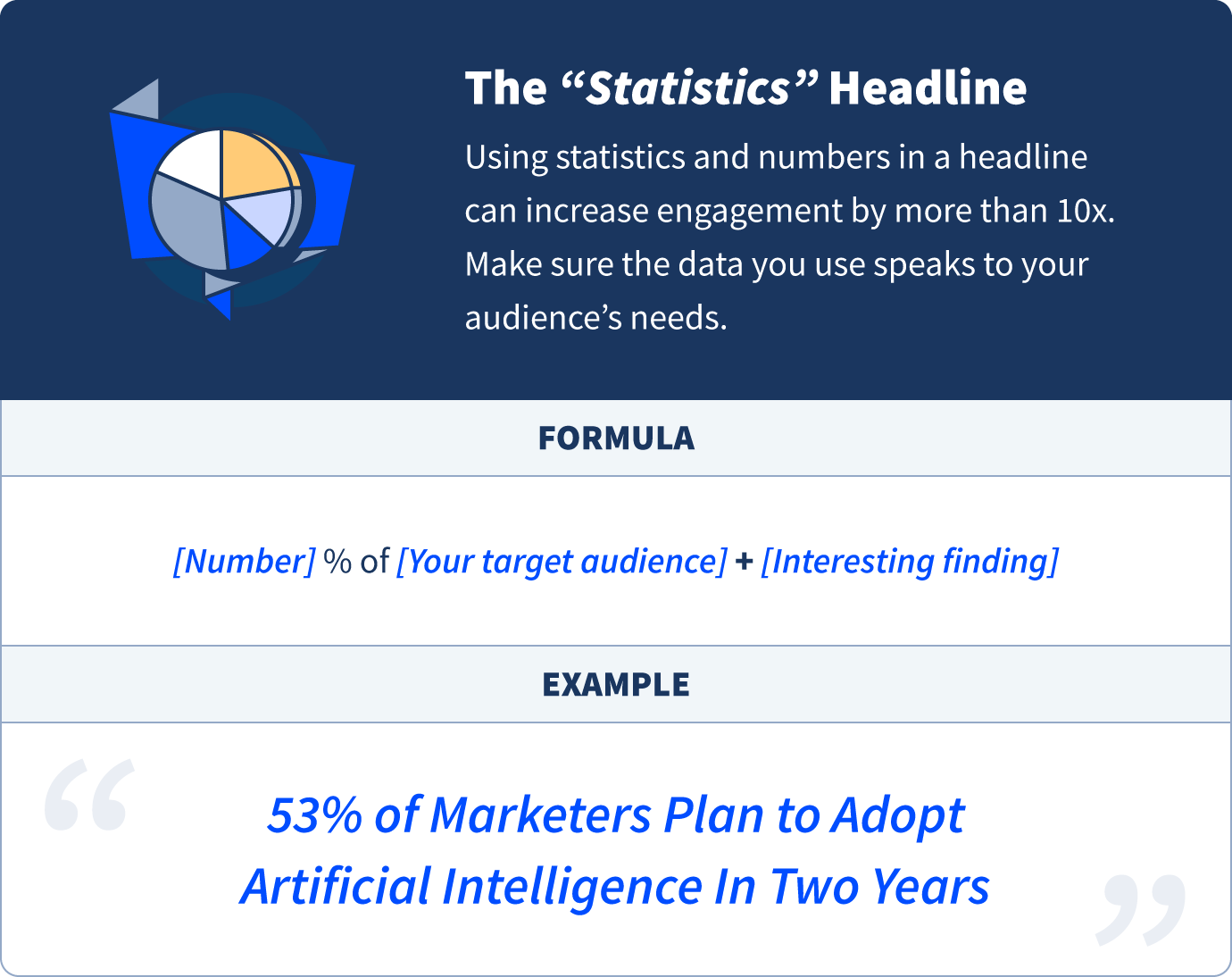
A study found that using statistics and numbers in a headline can increase engagement by more than 10x. You can add a statistic to one of the other headline types on this list to add more authority and grab the users’ attention.
To use statistics in your headlines successfully, make sure the data speaks to your audience’s needs. Would your potential readers find the information relevant? Would they want to know the reasons behind that data and what it means for them? Make sure you use statistics in your headlines responsibly. Some marketers use them in a misleading way and end up losing the users’ trust.
Formula
- [Number] % of [Your target audience] + [Interesting finding]
Examples
- 53% of Marketers Plan To Adopt Artificial Intelligence In Two Years
- 40% of Americans can't cover a $400 emergency expense
- Almost 70% of millennials regret buying their homes. Here’s why
The “Finality” Headline
If you have long-form, comprehensive content, consider adding words like “ultimate,” “complete,” or “definitive” to your headline. The finality headline is a good choice for serious and technical types of content. When users read “The Complete Guide,” they know they’ll find the most comprehensive guide on the topic they want to learn about.
To use a finality headline successfully, make sure you can deliver what you’re promising — which is a super informative guide. If you do, you’ll probably earn a new reader. In addition to the words mentioned above, you can also use words like “best,” “exclusive,” “guaranteed,” etc., to convey an idea of completeness.
Formula
- The [Complete/Definitive/Ultimate] Guide to [What your Audience wants to learn]
Examples
- The Ultimate Website Launch Checklist for 2021
- Evaluating Online Resources: The Complete Beginner’s Guide
- Best Website Builders in 2021
The “Controversial” Headline
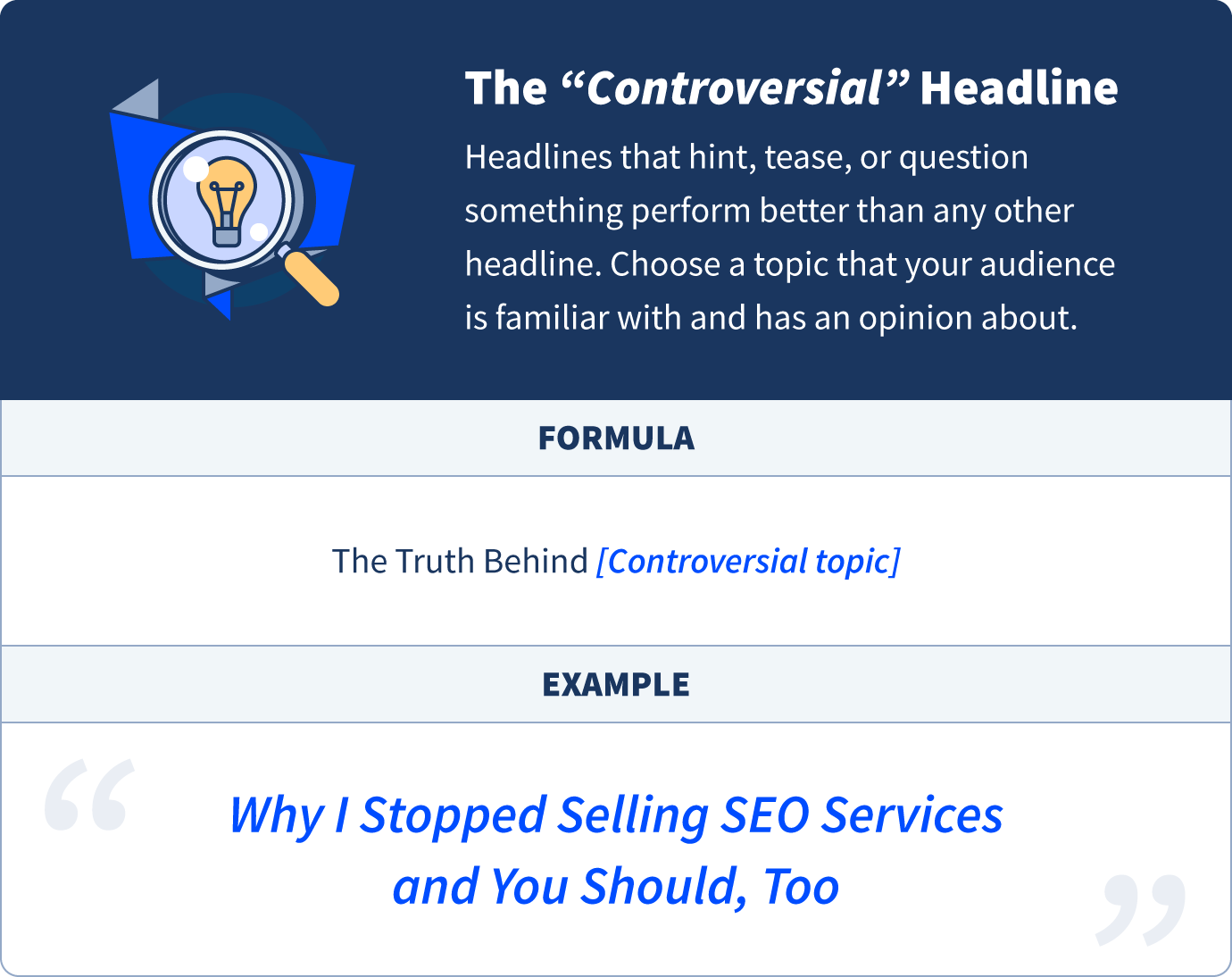
A study of 100 million posts conducted by Buzzsumo found that headlines that hinted, teased, or questioned something performed better than any other headline on Twitter. If common and simple headlines aren’t working and you want to experiment with new ways to catch the users’ attention, you should try using controversy in your headline.
Controversial headlines can help not only grab the users’ attention, but they’ll also involve readers in a discussion and invite them to leave their opinions (for example, in the comments section).
To create a successful controversial headline, choose a topic that your audience is not only familiar with but likely also has an opinion about. Make sure you are not disrespectful to your audience. Your goal is to pull new users in, not push them away. While there isn’t a fixed formula for this type of headline (you can essentially use any type of headline and add a controversial topic) below are some formulas you can use as a jumping-off point.
Formula
- The Truth Behind [Controversial topic]
- [Popular topic among your audience] Is Dead
- Everything You Know About [Popular topic among your audience] Is Wrong
Examples
- Why I Stopped Selling SEO Services and You Should, Too
- The ‘Hybrid Office’ Could Be Great. It Could Also Be Hell.
- Want to Raise Successful Daughters? Science Says Nag the Heck Out of Them
The Secret Sauce to Creating a Great Headline: Do's and Don'ts
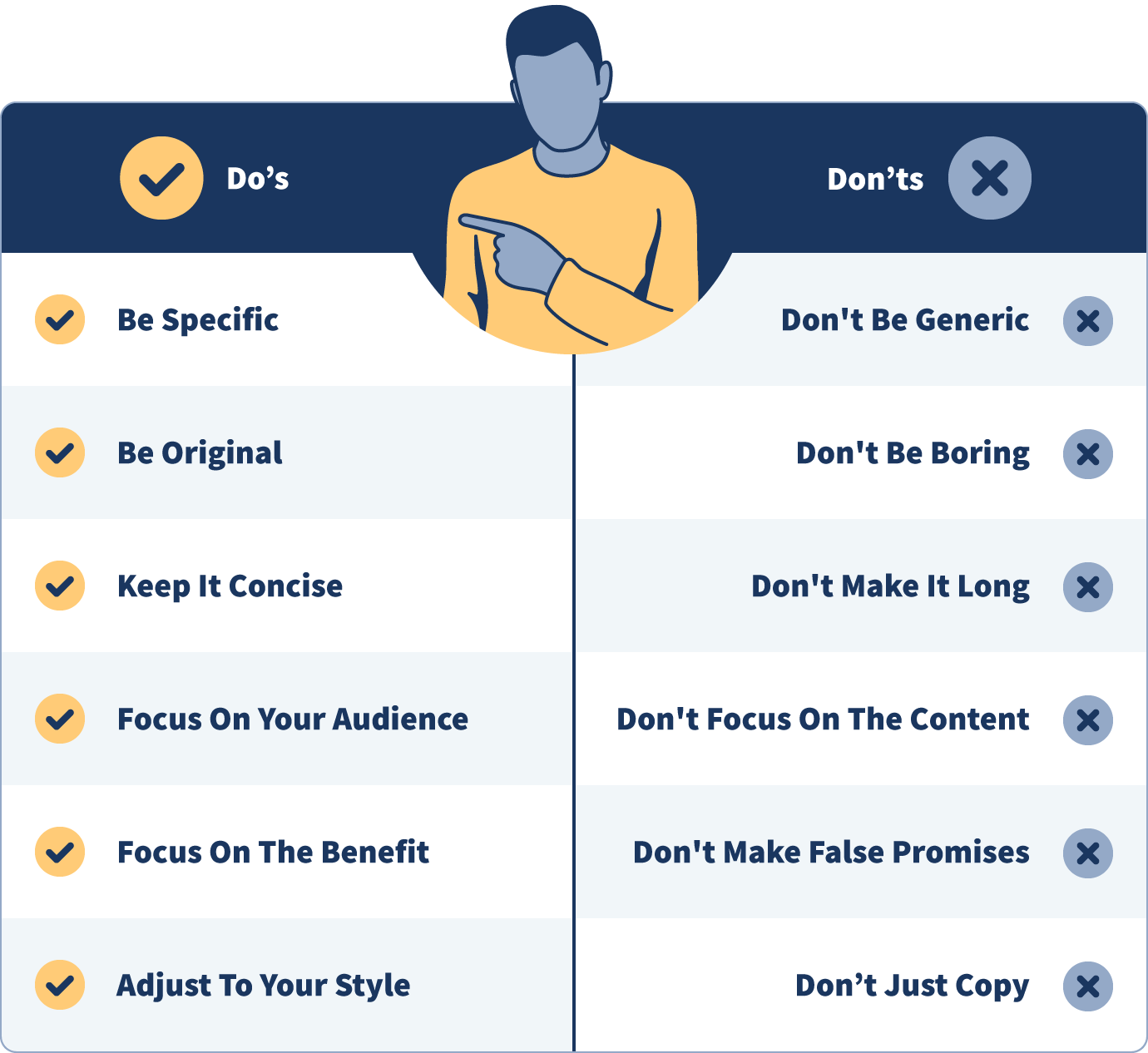
There are many factors you should consider when writing a headline that users will want to click on. While it’s important to experiment with different headline types and formulas, here are some general best practices and things to avoid when writing a headline.
Headline Do’s
-
Be Specific
Be specific when describing your content in the headline. What type of format is it? Who is the content meant for? To be specific, consider using numbers in your headline. If you’re not creating a listicle post, use the statistics headline formula to stand out.
-
Be Original
Your headline is the hook to your content. Even if your topic has already been covered, a unique headline can make you stand out from your competitors. To write an original title, look at the headlines that are ranking on Google for your keyword, and think about how you can make yours unique.
-
Keep It Concise
While your headline should be specific, it’s also important that it’s short and to the point, for two reasons. First, a shorter headline will read well in search engine results. Second, users will simply take less time to read it and decide whether they want to click. In many cases, a shorter headline will also stand out. According to the Buzzsumo study, the ideal headline length is 11 words and 65 characters.
-
Focus On Your Audience
To write a successful headline, it should be addressed to a specific audience, which is probably your target customers. Look at your buyer persona, and try to address their challenges and goals in your headlines. What type of words will resonate with them most?
-
Focus On The Benefit
Not only should your headline be addressed to a specific audience, but it should also be focused on the benefits your content will bring to them. Many copywriters make the mistake of focusing the headline on the content rather than its benefits to the reader. Instead, you should think about what goals your content will help them achieve.
A good way to hook your audience is by using dynamic and active language that will hint at what’s disclosed in the content. Verbs like “increase,” “drive,” and “boost” can help create a sense of urgency and grab the users’ attention.
-
Adjust To Your Style
While you can look at other content to find headline ideas, the best headlines will be the ones that speak directly to your audience. Not all headline formulas work for all businesses. The right headline will mirror your writing style and brand.
Headline Don'ts
-
Don't Be Generic
When writing headlines, make sure you’re not too vague. Don’t limit your headline to a description of the content. A generic headline example is “How To Make a Website.” A better headline would be “How to Make a Website in 2021: Step-by-Step Beginner's Guide.”
-
Don't Be Boring
Your headline shouldn’t bore your audience. Instead it should be interesting enough to grab the users’ attention. The controversy headline is a great example of a formula for how to write a headline that isn’t boring.
-
Don't Make It Long
Don’t make your headline so long that Google and other search engines won’t be able to display it entirely on search results. Your headline should not be longer than 60 characters.
-
Don't Focus On The Content
While you should be specific when describing your content (e.g., format, timeframe, etc.), you won’t be able to stand out and appeal to your audience if you focus on the content exclusively. Instead, think about the real-life problems your content can help users overcome or the goals it can help them achieve. Why should they open it? What goal will it help them achieve? What problem will it help them overcome?
-
Don't Promise What You Can’t Deliver
One of the worst mistakes you can make is using a catchy headline to get users on the page and then failing to deliver your promise. Make sure your headline isn’t just interesting and fun, but that it’s also truthful of what the content is about.
-
Don’t Just Copy
Just because a type of headline seems to work for others, that doesn’t necessarily mean it will work for you. Depending on your industry and target audience, some headlines will resonate well while others might appear spammy or out of context. It’s good to see what works for others, but make sure you adjust the headlines to match your brand and industry style.
How to Write a Headline that Stands Out
The right headline will match the type of content you’re delivering, so it has to be specific in describing what your article is about. To craft a specific headline, you can include a particular audience you’re trying to reach, like “beginners.”
With that said, your headline also needs to stand out from the rest. To write a unique headline for an article, see what’s currently ranking on Google. How can you make yours more interesting? Consider using interesting data and social proof.
Writing headlines that work for your business can take time and may require trial and error. If you’re willing to experiment with new headlines and analyze results, you’ll be able to reach your audience more effectively. When you have a piece of content ready, write multiple headline examples, and think about which one better suits the content you’re delivering. Is your content informational or is it more entertaining? Use words that refer to your audience’s pain points and goals. Try multiple headline formulas and don’t forget to analyze the results. If you’re struggling to come up with headline ideas, try out our headline generator at the top of this article.

